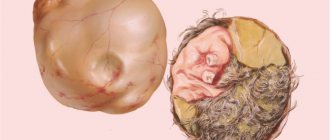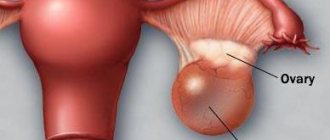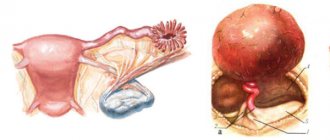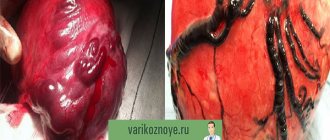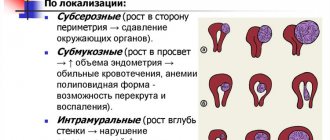The female reproductive system is exposed to many diseases, one of which is ovarian hydatid (ICD 10 code No. 83). This neoplasm does not harm the patient’s body until it reaches a large size. With large parameters, the tumor can lead to infertility. In order to understand what ovarian hydatid is, what are the signs of formation, why it occurs and how to treat the disease, it is necessary to study the pathology in more detail.
What is hydatid ovary
Many women who have this diagnosis are wondering: ovarian hydatid - what is it? It is important to understand that this is a neoplasm that most often occurs at the base of the ovary. That is, its location is the fallopian tubes.
The danger of this pathology is that the woman may remain infertile. Hydatida blocks the release of the egg from the ovary and prevents it from moving through the tube. And this, in turn, leads to the inability to get pregnant, since the sperm is simply not able to reach the egg and fertilize it.
A hydatid is a cyst (pathological cavity) filled with fluid inside. On ultrasound examination, the neoplasm is detected in the form of a circle or oval with clear outlines. Most often, the disease does not cause any particular concern, but may manifest itself with some symptoms.
Diagnostics
Hydatida is mainly diagnosed incidentally during a routine ultrasound examination.
If we talk about a standard examination on a gynecological chair, then a neoplasm can be detected if it is large.
Then doctors use the palpation method.
Ultrasound images show an oval or round tumor with clearly defined and dense walls. The capsule itself is filled with a transparent liquid. The doctor characterizes it as an anechoic spot.
Symptoms of the disease
It is important for women to monitor their health and pay attention to even minor changes in their condition; this is the only way to detect ovarian hydatid in time. Symptoms that should alert you are:
- frequent pain in the lower abdomen (may be spasmodic or acute);
- increase in body temperature;
- state of weakness and irritation;
- spotting for a long time;
- disruption of the menstrual cycle;
- a woman cannot become pregnant, given that sexual intercourse is regular.
Of course, these signs may indicate other diseases. But if they are observed, it is recommended to immediately consult a doctor. Timely help will help you avoid many problems that threaten infertility, as well as determine whether it is caused by ovarian hydatid (what it is, you already have an idea).
Symptoms
To determine the formation of ovarian hydatid, to understand what it is, you need to know what symptoms it causes. Such knowledge will help you immediately suspect a violation and promptly contact a specialist for help.
Women need to pay attention to the following clinical manifestations:
- Regular pain in the lower abdomen. They can be easily confused with diseases of the digestive system. The pain syndrome can be acute and spasmodic.
- High body temperature that is not accompanied by symptoms of a cold or flu.
- Weakness throughout the body, irritability, tendency to sleep.
- Spotting vaginal discharge observed over a long period of time.
- Menstrual irregularities.
- Problems conceiving a child, despite regular sex life.
These clinical manifestations are the result of completely different pathologies. In this regard, a mandatory examination of the woman is required, which will help make an accurate diagnosis.
Causes of the disease
In order to help preserve a woman’s reproductive health and in the future avoid many problems associated with childbirth and pregnancy, you need to know what can cause ovarian hydatid to develop. The reasons for its occurrence are quite numerous:
- Ectopic pregnancy, which subsequently leads to inflammatory processes and poor functioning of the fallopian tubes.
- Miscarriages, abortions, which, by the way, are the main factors provoking the growth of hydatids.
- Pelvic surgeries that cause a decrease in immunity and a weakening of the protective functions of the woman’s reproductive system.
Reasons for the appearance of hydatid
Many people mistakenly believe that hydatides occur due to a hormonal disorder, an inflammatory process, or an unhealthy lifestyle, but this pathology is exclusively a congenital feature.
There are reasons that predispose to the development of hydatids. All these reasons are associated with the characteristics of pregnancy in the mother:
- Taking medications by a pregnant woman with harmful or unknown effects on the fetus.
- Harmful living or working conditions: working with pesticides, radiation pollution, chemical unsafety, working with paint and varnish products.
- X-ray examination during pregnancy.
Working with pesticides
The influence of all these factors is important from 8 to 20 weeks of pregnancy, it is during this period that the genital organs of the fetus are formed.
Hydatida Morgagni
Neoplasms in the form of cysts can occur either singly or in groups. If these are solitary cysts that are not causing concern, they may not need to be treated. In addition, they usually do not interfere with pregnancy. When there are a lot of cysts, treatment is required.
These neoplasms are often round and oval in shape. Their surface is smooth and reaches a size of about 2 cm.
Cysts hang on a pedicle, they are also called fallopian tube appendages. To test a woman for the presence of hydatid, an ultrasound examination is required. With its help, the fallopian tubes are diagnosed for patency and neoplasms. When the hydatid grows up to three centimeters in diameter, it can cause unpleasant sensations:
- feeling of discomfort;
- aching pain in the groin area;
- pain at rest.
If severe acute pain occurs, this may indicate twisting of the cyst. In this case, immediate surgical intervention is required.
Kinds
Hydatids can form on the ovary and/or fallopian tubes. For a woman who wants to get pregnant, a new growth on the fallopian tubes poses a huge danger.
In addition, pathology is divided into the following types:
- Single formations. Women do not pose a threat to health if the size does not exceed 2 cm and is located only on one of the ovaries.
- Multiple formations. Requires urgent medical attention.
With bilateral damage, urgent treatment is also required. Most often, harmless cysts are found on one of the ovaries.
Hydatid ovary and fallopian tube
We hope you now understand the term “ovarian hydatid”. It has already been said that this is a neoplasm that occurs at the base of the ovary or in itself, but hydatides also appear in the fallopian tubes. The main reason for their occurrence here is infection.
Hydatids are called not only cysts, but also adhesions. They are formed, as a rule, as a result of abortions or previous operations. If there are many hydatids in the fallopian tube, then experts diagnose “obstruction of the fallopian tubes.” These neoplasms completely block the channel for the release of the egg or narrow it, which also leads to the impossibility of fertilization.
If there are no complications, then hydatid is not treated. Specialists prescribe only drug treatment and observation.
Hydatid is considered a benign neoplasm, but it can increase in size. Fortunately, it does not degenerate into malignant tumors, and most women do not even know that they have the described pathology in their ovary or fallopian tube. Many people can live with it their whole lives.
Consequences
The nature of hydatid is benign, the possibility of degeneration into a malignant formation is almost zero, but there have been cases, so the pathology should not be ignored.
If the disease is neglected, there is a high risk of the following complications:
- Infertility associated with tumor growth. The cyst puts pressure on the soft tissue, creating obstacles for the penetration of eggs and sperm into the fallopian tubes, disrupting the functioning of the ovaries, as a result of which ovulation may be absent.
- Torsion of the legs. Causes tissue necrosis, fever, and severe pain. Urgent surgery required.
- Rupture of the neoplasm. Occurs with large hydatids and threatens peritonitis and sepsis. Accompanied by sharp, unbearable pain, internal bleeding, and suppuration in the abdominal cavity. Medical attention is required immediately, as internal infection is possible.
The neoplasm does not pose a serious health hazard, but treatment is mandatory. If the disease is neglected, infertility can become incurable. In most cases, single formations go unnoticed by a woman throughout her life, do not cause any symptoms, and do not interfere with life. But if suddenly the tumor begins to grow and cause discomfort, then therapeutic measures cannot be avoided.
You shouldn't be afraid to visit a doctor. He will tell you what ovarian hydatid is and prescribe effective treatment, based on the individual characteristics of the body.
Treatment of ovarian hydatid
But how to get rid of tumors when diagnosed with ovarian hydatid? Few people also know that this is a treatment that requires surgical intervention. True, patients are operated on only in cases of hydatid overgrowth. And this is mainly laparoscopy.
The doctor sets the day for the operation and prepares the patient for several days. The patient undergoes all tests and is examined. The anesthesiologist prepares the patient for anesthesia, as it will be general, due to the extensive operation.
If laparoscopy is not suitable, then the operation will be abdominal. Afterwards, the patient remains in the hospital for about seven days. This is taking into account that there will be no complications. Abdominal surgery is more complicated and, accordingly, it takes longer for the body to recover.
There are also many alternative treatments.
Needle biopsy in the treatment of the disease
A new type of treatment can be tried by women who, unfortunately, know: ovarian hydatid - what it is. The puncture biopsy method is relatively new, and for its implementation there must be certain indicators:
- The cyst is more than two centimeters in diameter.
- It should be visible in the second phase of the menstrual cycle.
- The presence of free fluid in the pelvis.
A specialist uses ultrasound to perform a therapeutic puncture. It should reduce or completely eliminate the tumor. If everything went well, then the dynamics can be traced only within one year. A therapeutic puncture is considered only when there is no relapse of the disease.
Ovarian hydatid: treatment with folk remedies
Mostly, patients who have been given this diagnosis try to avoid surgical intervention. Then the question arises: if the diagnosis is “ovarian hydatid,” how to treat it?
Traditional recipes can come to the rescue, but we must remember that in most cases they are only suitable for prevention. When the disease is advanced, it is still recommended to find a highly qualified specialist and consult. Folk remedies are great for preventing the disease.
Dandelion root is considered a good way to prevent cysts. It is an effective antibacterial, anti-inflammatory and anthelmintic agent. Infusions are made from the root. You need to finely grind it, pour boiling water and leave for several hours, then take a teaspoon twice a day. For the same purposes, boron uterus and burdock leaves are used.
